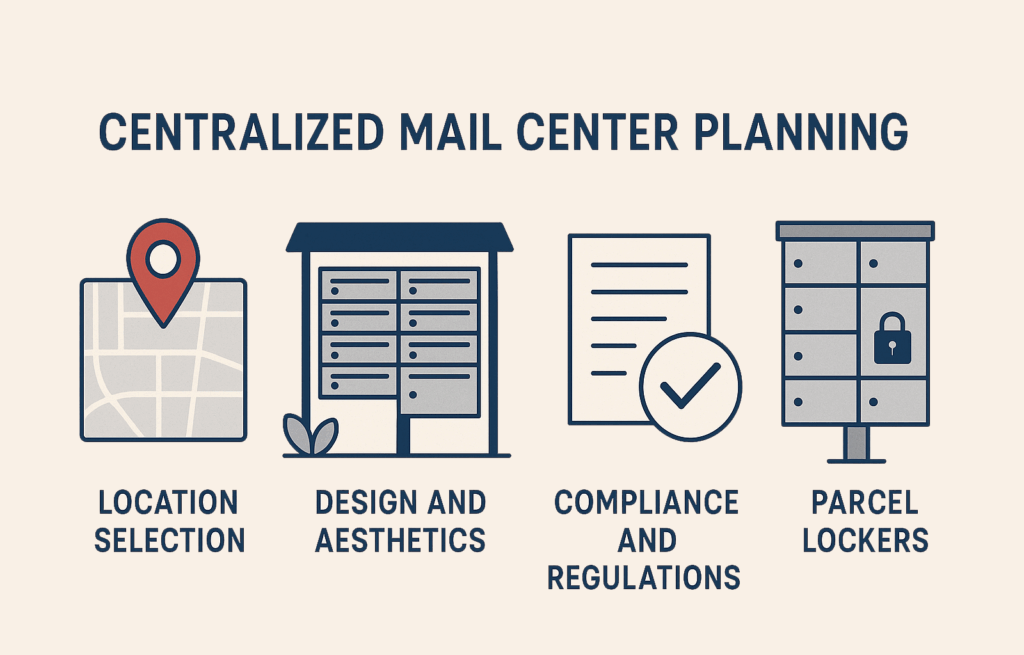New construction development: Centralized mail center planning
In today’s rapidly growing residential and mixed-use developments, centralized mail centers are becoming an essential part of community infrastructure. Proper planning and implementation of these mail centers not only ensure compliance with postal regulations but also improve resident convenience and contribute to the overall functionality and aesthetics of the development.
Why centralized mail centers matter
Centralized mail delivery systems — commonly referred to as Cluster Box Units (CBUs) — have become the preferred method for new residential developments due to their efficiency, security, and cost-effectiveness. The United States Postal Service (USPS) strongly encourages centralized delivery for new builds, and in many cases, mandates it.
Benefits of centralized mail centers
- Increased efficiency: Mail carriers can deliver to multiple residents at one stop, reducing delivery time and postal service costs.
- Enhanced security: Locked mailboxes protect against theft and unauthorized access.
- Reduced environmental impact: Fewer delivery stops mean less fuel consumption and lower carbon emissions.
- Community integration: When well-designed, mail centers can serve as community touchpoints.
Planning a centralized mail center: Key considerations
To ensure functionality, compliance, and user satisfaction, developers must consider multiple factors when planning a centralized mail center.
1. Location selection
Choosing the right location for the mail center is crucial.
- Accessibility: The site should be easily accessible to all residents, ideally located along a main pedestrian path.
- Visibility: A visible, well-lit area helps deter vandalism and ensures ease of access, especially at night.
- ADA compliance: All mailboxes must be accessible to individuals with disabilities, meeting ADA height and space requirements.
2. Design and aesthetics
The mail center should complement the community’s architectural style and branding.
- Enclosures and shelters: Consider covered structures to protect users from the elements.
- Material choices: Use durable, low-maintenance materials that withstand weather and wear.
- Landscaping: Integrate surrounding greenery or hardscaping to improve aesthetics and user experience.
3. Compliance and regulations
Developers must comply with USPS guidelines and local building codes.
- USPS approval: Submit mail center plans to the local postmaster or USPS Growth Manager early in the design phase.
- Space requirements: Allocate sufficient room for CBUs, parcel lockers, and clearance space around units.
- Lighting and security: Ensure the site is well-lit and consider surveillance for additional security.
Additional features to enhance user experience
Beyond basic compliance, thoughtful additions can elevate the user experience and value of the mail center.
Parcel lockers and package management
With the rise in online shopping, parcel lockers are essential for secure package delivery and pickup. They should be included within the mail center design or as a separate unit nearby.
Bulletin boards and community notices
Adding bulletin boards allows property managers or HOAs to share updates, fostering a sense of community and keeping residents informed.
Waste and recycling solutions
Provide nearby trash and recycling bins for packaging waste, helping maintain a clean and pleasant environment.
Conclusion
Centralized mail center planning is more than a logistical necessity — it’s an opportunity to improve functionality, community cohesion, and resident satisfaction in new developments. By considering location, design, compliance, and additional amenities, developers can create mail centers that enhance both form and function.
Please note that the USPS updates standards and information periodically. Always check with your local Postmaster before proceeding with mail center projects.
Have questions? We’re here to help.
The Mailbox Directs team is always available to assist with your mailbox project. Let us help you build a cluster mailbox solution for your neighborhood or building complex.

